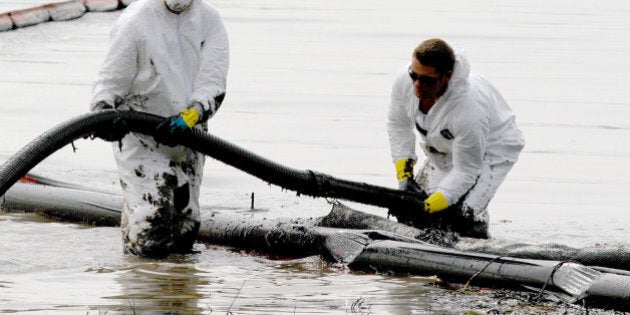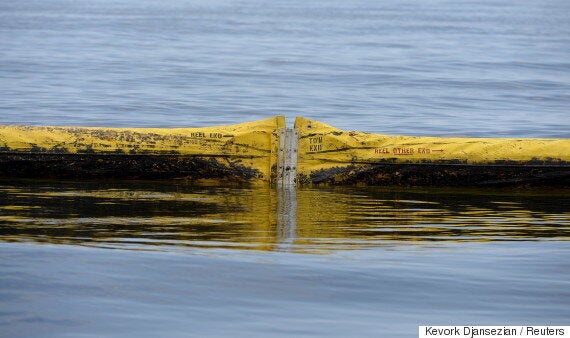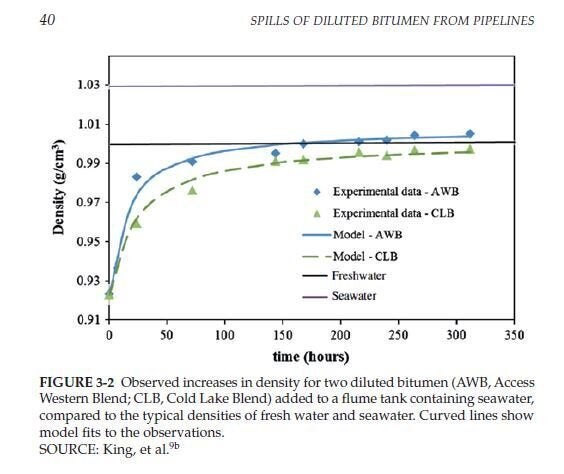
One of the most misunderstood issues in the Trans Mountain Pipeline Expansion (TMX) debate is what happens to diluted bitumen (dilbit) in a marine spill. The common misconception is that "bitumen sinks". The truth is that both bitumen and dilbit float in the marine environment.
The misconception is based on a misreading of a US. National Academies of Science (NAS) report from 2016. The NAS report is an expert review of the literature intended to address a regulatory requirement governing "spill response planning, preparedness, and clean-up." The scientists who wrote the NAS report did no original research, rather they rely on the research of others.
For bitumen behaviour in a marine environment the NAS relied on work by Environment Canada, Fisheries and Oceans Canada and Natural Resources Canada. For referencing purposes any physical data/observations in the next few paragraphs are straight out of that Environment Canada technical report.
To start, dilbit consists of a mixture of 20 per cent to 30 per cent diluent and 70 per cent to 80 per cent bitumen. The diluent is typically a light-hydrocarbon mixture (like naptha) called "condensate." Bitumen has a density of 0.998 g/mL while the condensate has a specific gravity around 0.6 g/mL. The resultant dilbit has a density/specific gravity around 0.92 g/mL.
This actually makes dilbit easier to skim off the surface early in a spill event.
Since we know that freshwater has a density of 1 g/mL and seawater's density ranges from 1.025 g/mL to 1.033 g/mL that means that when spilled any dilbit will initially float (like the oil in your bottle of oil and vinegar salad dressing) in both fresh and marine waters.
Historically it was believed that as spilled dilbit weathered the diluent would all evaporate away and the resulting evaporated mass would sink. Well, the research says that this is not the case.
The Environment Canada research show that even with pretty much all the diluent evaporated the resultant evaporated dilbit still retained a specific gravity (at 0 degrees Celsius) of 1.02 mg/L. Thus the material would not sink in marine spills but would remain afloat.
More interestingly, when lighter crude oils are hit with breaking waves they form small droplets that lack the buoyancy to float and will often remain entrained in the water column. The dilbit did not act in this way. Rather when the experimental dilbit was exposed to a wave pool it formed much larger droplets which they called "oil balls" that quickly resurfaced and coalesced into a surface slick. This actually makes dilbit easier to skim off the surface early in a spill event.

The Achilles heel of the dilbit, however, appears to be sediments in the water. Oils exposed to silty water will form oil-particle aggregates (OPAs) which under certain conditions will sink to the bottom. In the Environment Canada research when they mixed the spilled dilbit with high concentrations of a very fine type of clay called "kaolin" virtually all the bitumen either dispersed or formed OPAs and sunk to the bottom of the wave tank.
Modelling exercises by Fisheries and Oceans Canada using the approximate sediment load and characteristics of the Douglas Channel concluded that approximately 20% of the diluted bitumen would form OPAs which would sink below the sea surface, with little of that material actually sinking to the sea bottom. Coincidentally, that is pretty much the same behaviour one would expect from a typical crude oil spill. A stochastic model of an oil spill in the Salish Sea suggests that the majority of the oil would stay on the surface, and accumulate on the shoreline, rather than dispersing into water column. Once again a spill would be a tragedy, but the behaviour of the diluted bitumen would be no different from a similar crude oil spill.
The NAS report covers all this ground and even includes a Figure (Figure 3-2 presented below) that shows how evaporated bitumen retains a density less than seawater. The problem is that the authors wrote the NAS report for a technical audience in language that non-specialists apparently find challenging to understand. As a consequence many end up reading the section on freshwater behaviour and apparently get confused.

Since freshwater is less dense than seawater whether spilled dilbit will sink or float becomes far more dependent on the source material and ambient temperature. As the NAS figure indicates, highly-weathered Cold Lake Blend will retain a density less than 1 g/mL (it will float in freshwater) while Access Western Blend will reach a density above 1 g/mL (it will sink in freshwater). We also have to consider environmental conditions.
Consider the Kalamazoo spill which occurred during a heavy rainfall event where the river was filled with sediments. In that case events conspired to produce a scenario where a majority of the material formed OPAs and sank to the bottom. What is most interesting about that spill is that under those conditions a typical crude oil would likely have behaved in a very similar manner. At those sediments levels OPAs were inevitable.
To be clear, any oil spill, be it crude or diluted bitumen, represents a tragedy and catastrophe. The point of this blog post, however, is to establish whether diluted bitumen sinks in a marine spill; since that is what the activists fighting TMX keep insisting. In response the research is clear: dilbit doesn't initially sink when spilled in seawater, it floats and, in the absence of heavy sediment loads, keeps floating even after days of evaporation.
Follow HuffPost Canada Blogs on Facebook
Also on HuffPost:
